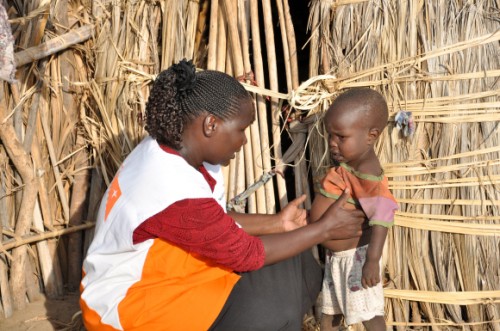Antibiotics Used in Treatment of Kwashiorkor, Marasmus Malnutrition
This article is not so much for anyone I know – except, perhaps someone entering the Peace Corps – but to provide “closure” so to speak for an issue that I saw a lot of during my medical training (Vietnam War era). I wanted to write about some new research in the treatment of severe malnutrition (Marasmus and Kwashiorkor) in children; however, I’ve had a heck of a time trying to find the usual photograph to accompany the article.
Scouring both Bing and Google for images only produced images so desperately unsettling that I wouldn’t think of using them on the blog; but I eventually did find one to use. Just be aware that the one I’ve used is of only a mild case and anyone who’d like to see more is encouraged to do a web-image search themselves.
The New England Journal of Medicine (published online Jan 31, 2013) reports of a collaborative, randomized, double-blind, placebo-controlled trial study done largely in Blantyre, Malawi. They treated children aged 6 to 59 months who had evidence of kwashiorkor and/or marasmus and they found 2,767 in the short time of their investigation.
Marasmus is a severe form of total calorie malnutrition and produces severe wasting, weakness and other effects. Kwashiorkor is produced by a severe protein malnutrition and includes liver enlargement, ascites (fluid in the abdomen), stunted growth etc. And there is a third type: Marasmic Kwashiorkor (both of them together) which is much more difficult to treat.
Until now treatment of these diseases is largely on solid scientific grounds only as far as the replacing nutrition goes. However, because there is often noticed high rates of clinically significant infections in malnourished children, it has been “expert opinion” to use antibiotics on all of them, even when they are being treated outpatient. Of course, using antibiotics have themselves a lot of side-effects so could actually cause more problems.
All of the children in the study received the ready-to-eat food treatment which has been shown to be effective. In addition, however, they were randomly assigned to one of three different antibiotic study groups during the initial seven days of treatment: Amoxicillin, Cefdinir and “none” .
The great thing that they found was that both the antibiotic groups were associated with higher rates of recovery than the children in the placebo group and at a high level of statistical significance. In addition, these same groups were less likely to die of the disease – yes, that is a real possibility.
When they looked even further into the statistics they also confirmed some other correlations which were expected. Those children with only one of the types of malnutrition did better than those who had the Marasmic Kwashiorkor, as did those whose height hadn’t yet been effected by malnutrition. Lower odds of recovery were associated with those testing positive for AIDS in either the child or the mother.
The good and bad of the final results were that 88.3% of the children in the study eventually recovered; meaning, 11.7 percent did not. There didn’t seem to be any difference between which antibiotic was used. Why this represents “closure” for me is that we saw a hundred or so of these malnourished children in our hospital at the end of the war and we agonized over each child about whether or not to put them on antibiotics.
Of course the ones we were treating were those who were admitted because of diarrhea which is one of the effects of malnutrition. For our kids, if you fed them (or gave them antibiotics) their diarrhea – which they had anyway – got worse. Talk about being between a rock and a hard place. I’m glad to now know there is evidence that using antibiotics helped in this study.
[N Engl J Med. 2013;368:425-435.]

